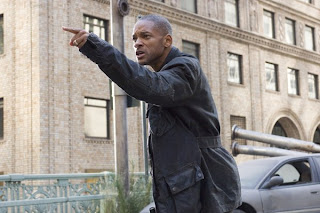 One of the publications that I enjoy related to the subject matter of this blog is the Journal of Religion and Film. The film reviews and analysis cover a variety of genres, and they include a fair number of discussionjs related to science fiction and horror. It had been a while since I went to the website to see if a new edition had come out, and to my pleasant surprise Vol. 12, No. 1 (April 2008) is now available. As I scanned the contents two items were of interest, both film reviews, one for Pan’s Labyrinth, and the other for I Am Legend. With this post I will share some brief comments on my twofold disagreement with the conclusions of the latter review by Christopher M. Moreman of St. Francis Xavier University.
One of the publications that I enjoy related to the subject matter of this blog is the Journal of Religion and Film. The film reviews and analysis cover a variety of genres, and they include a fair number of discussionjs related to science fiction and horror. It had been a while since I went to the website to see if a new edition had come out, and to my pleasant surprise Vol. 12, No. 1 (April 2008) is now available. As I scanned the contents two items were of interest, both film reviews, one for Pan’s Labyrinth, and the other for I Am Legend. With this post I will share some brief comments on my twofold disagreement with the conclusions of the latter review by Christopher M. Moreman of St. Francis Xavier University.
First, Moreman refers repeatedly to the film’s main character, Robert Morgan (played by Will Smith), as a Christ-figure. Why, we might ask? Because he attempts to save humanity from the devastation of the virus that has killed the bulk of humanity and turned most of the few remaining survivors into something akin to vampire-zombie hybrids. This sounds like a pretty slim reason to view Morgan as a Christ-figure. Some kind of savior (in non-religious terms) maybe, but more specifically, a Christ-figure? I need more convincing. Moreman does not hesitate to provide further reasons, claiming that Morgan’s character depicts a “balant Christ-figuration” by “raising the hero to the status of nearly divine savior. Will Smith (displaying the cruciform position in behind-the-neck pull-ups) saves humanity through his blood and sacrifice, allowing not only those who are already free from disease to survive, but providing the hope that those who are ill might themselves be saved and restored to humanity from their horrific, bestial state.” I’m afraid I’m still unimpressed. Smith’s pull ups appear to be little more than physical exercise for a human being desperately trying to maintain a routine and kill time as the supposedly lone survivor of a viral apocalypse. And this is hardly a “cruciform position,” unless of course you read such symbolism into the film. In my view, Moreman’s review provides yet another example of the unfortunate tendency of many film critics (professional and otherwise) to uncritically read Christ-figures into films, a phenomenon discussed by Christopher Deacy in The Journal of Religion and Popular Culture.
As Moreman concludes his review he echoes sentiments expressed by many on the relationship between the film and the Matheson novel upon which it is based. This leads to my second area of disagreement with him that he also connects to the area discussed above. Moreman writes:
“In short, I Am Legend does not put forth a faithful representation of its literary namesake, either in plot detail or underlying themes. Rather, the film follows on from other film versions in providing an increasingly hopeful ending. In this latest case, the religious (Christian) symbolism is blatantly transparent.”
I’ve already commented on the alleged Christian symbolism in I Am Legend, and whatever else might be said about it it is hardly “blatantly transparent.” Beyond that, while I have the greatest respect and appreciation for Matheson’s novel, and I would love to see a screen adaptation that is completely faithful to it to add to the cinematic depictions of this great story, I think it is a mistake to connect the success or failure of a movie on how closely it does or does not follow its source material. Most films do not closely follow their literary source material, so why should I Am Legend be considered sub-par because it does what most films do?
Please don’t mistake my disagreements and grumbling for a lack of appreciation for this publication, or a diversity of opinions on film interpretation. I respect both and I thought I’d provide my two cents by way of response.





There are no responses yet